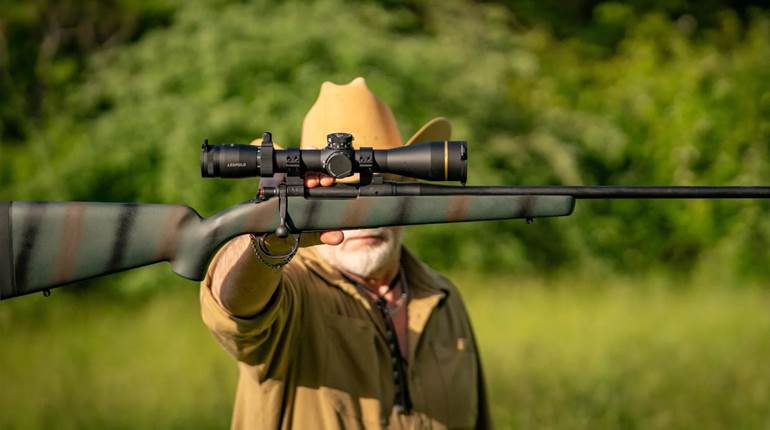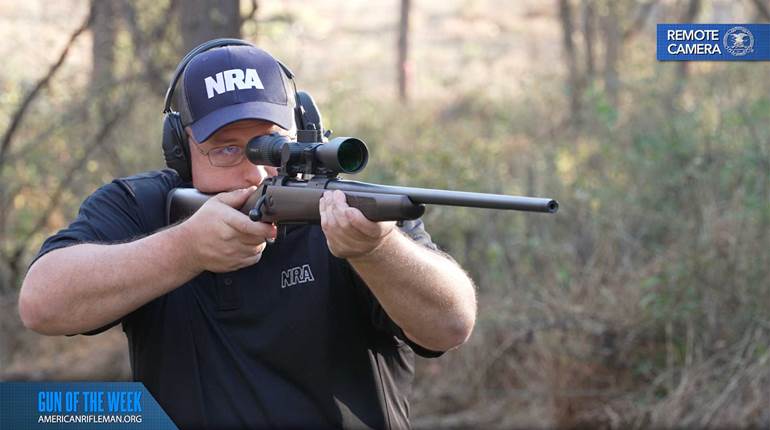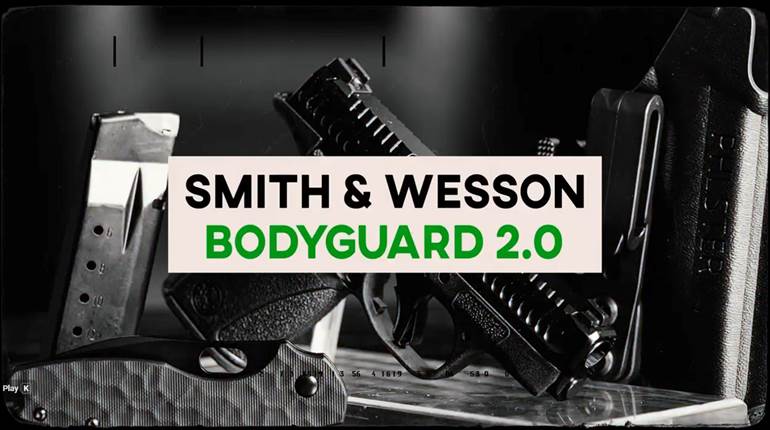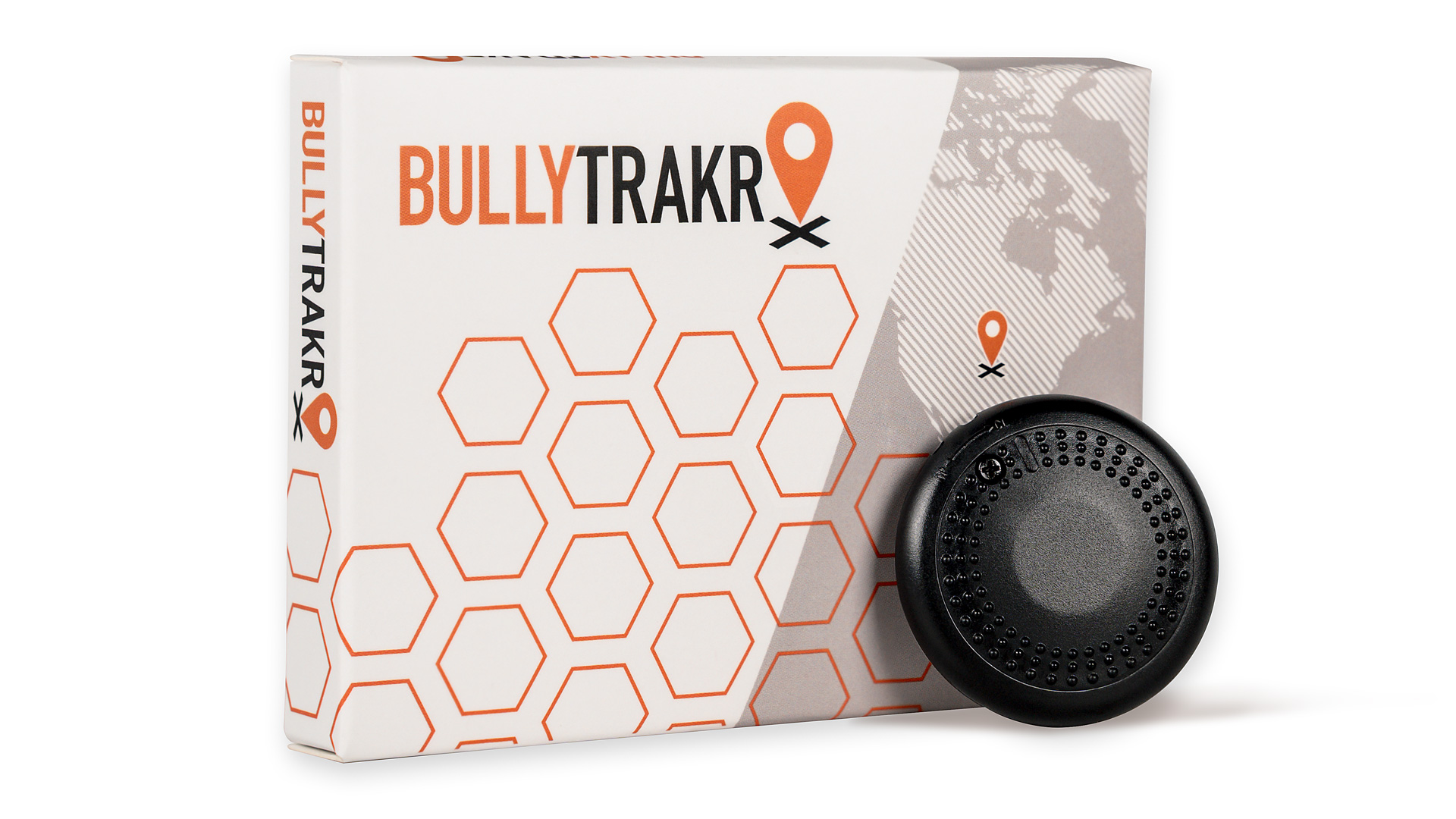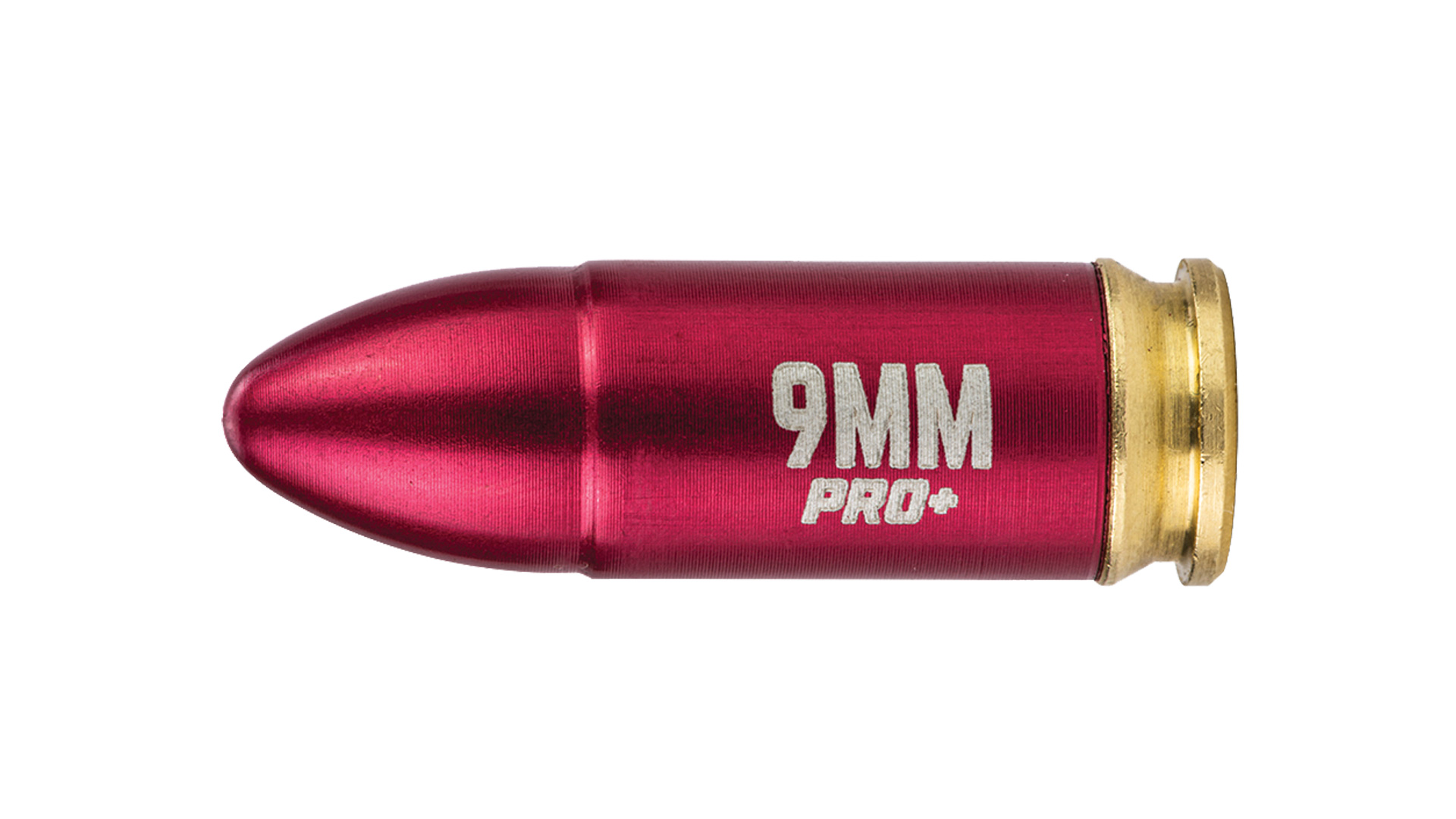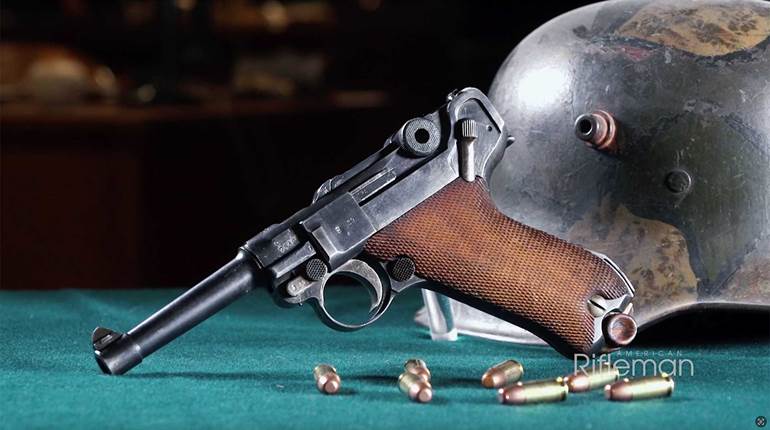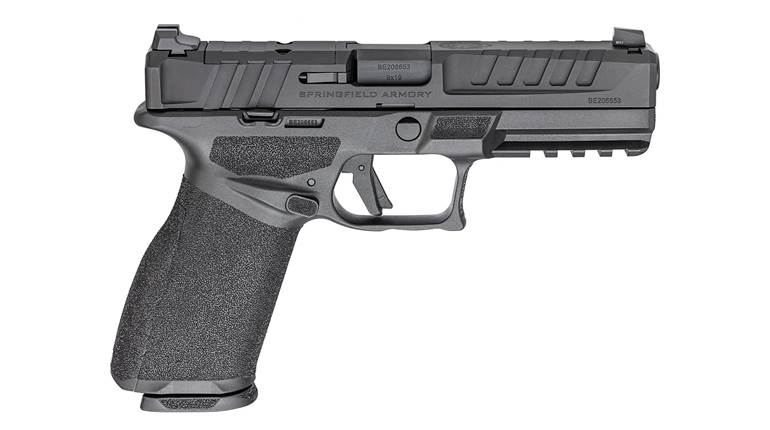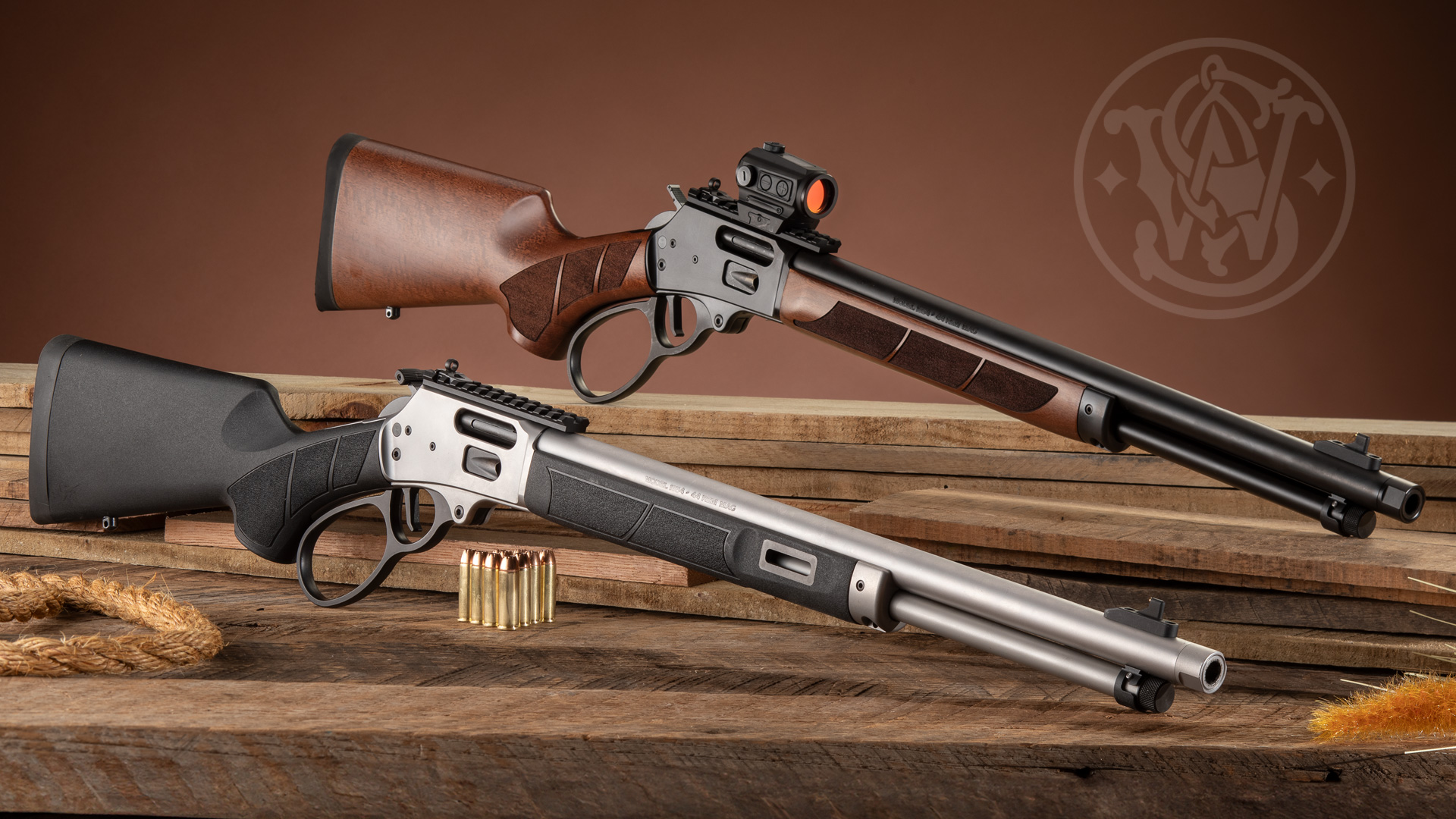
When a major gun manufacturer enters a new product category, the first reaction is often to ask, “Why?” And in the case of Smith & Wesson and its recently launched Model 1854 lever-action rifles, there are at least four answers provided by the maker itself: First, a new product always sparks renewed interest in a brand—even one as popular as S&W. Second, in this case, it helps move the iconic revolver manufacturer more firmly into the hunting space. Third, it helps to elevate an already well-known brand among the ranks of even more shooters—in this case, lever-action-rifle fanatics whose choices are more limited than those for fans of bolt-actions. Finally, the new Model 1854 line represents an opportunity for Smith & Wesson to reconnect with its past.
Though not commonly associated with the brand today, lever-actions—both handgun and rifle variants—were in the company’s DNA at its founding in 1854 just before it became the Volcanic Repeating Arms Co.—hence the new gun’s model designation. And while Horace Smith and Daniel B. Wesson’s lever-action short and long guns and improved Rocket Ball ammunition were short-lived, the partners would go on to form one of the most famous marques in American firearms, primarily making a name for themselves in revolving handguns, particularly during that format’s heyday within law-enforcement markets. Meanwhile, investor Oliver Winchester would eventually do quite well on his own providing western explorers and cowboys with lever-action rifles.
In Concept
A full 170 years later, Smith & Wesson President & CEO Mark Smith summed up the company’s new venture to reconnect with its past in staid, albeit apropos, terms: “Meticulously crafted, these rifles fuse the classic craftsmanship of the iconic lever-action with modern engineering to deliver a platform built on reliability and performance. Our new Model 1854 rifles are a nod to tradition and a testament to Smith & Wesson’s legacy as an American firearms manufacturer.” Indeed, the Model 1854’s design appears to effectively blend the classic American lever-action aesthetic with the enhancements that shooters of today’s more modern platforms have come to expect. Further, the guns’ understated appearance belies mechanical refinements garnered from a close study of the competition and implementation of product-development and testing protocols that have seen the company reap huge successes in the semi-automatic-pistol and AR-rifle segments.
Initial broad-market offerings include three models made with stainless-steel receivers and barrels: one with a natural finish and synthetic stocks featuring M-Lok slots at the front of the fore-end at the 3-, 6- and 9-o’clock positions; another with a polished black PVD finish and walnut stocks; and a Limited Edition version with the same dark finish and high-grade walnut. Even more exclusive examples of the Model 1854 lent punch to its introduction by incorporating fancy wood and inlaid engraving and were paired with like-chambered revolvers to benefit such organizations as Safari Club Intl. and the Rocky Mountain Elk Foundation.
The Model 1854 was first introduced in .44 Mag., and a .45 Colt version was just announced. The 36" long, 6-lb., 13-oz., gun is handy, yet the 19.25" barrel wrings the full potential from its ammunition—something I would come to appreciate later. Mounted to the receiver is a nine-slot Picatinny base measuring 43/4" in length with an inset, fully adjustable XS aperture rear sight to complement the XS gold-bead front sight. Since the base’s hole pattern matches that of the Marlin 1894, a variety of existing bases and rings could be substituted. A large-loop lever, crossbolt safety and distinctive flat-face trigger comprise the user-friendly controls. The gun features a traditional side gate in the receiver for loading and a somewhat unconventional removable underbarrel magazine tube.
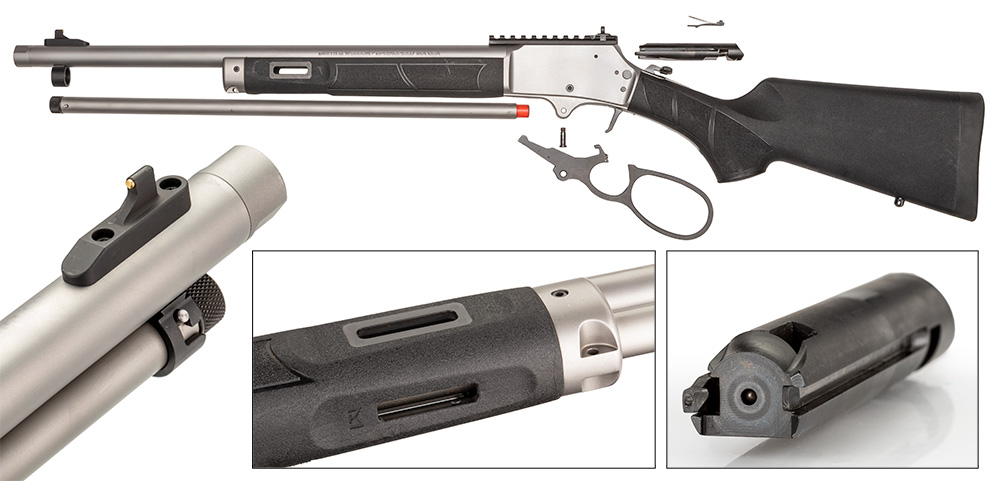
In The Field
The stainless-and-synthetic model is most immediately modern in appearance and, given its all-weather materials and aforementioned accessory mounts, unquestionably the more practical. I was fortunate to take temporary possession of one during a company-sponsored launch event several months ago. It proved to be an ideal test bed for our baker’s dozen hunters who set out after wild boar across the sometimes rainy, foggy environs that comprise Wilderness Hunting Lodge near Monterey, Tenn.—midway between Nashville and Knoxville in the foothills of the Cumberland Mountains. From the first day of hunting, the gun’s buttstock and fore-end texturing, borrowed from the firm’s well-regarded polymer handgun line, proved particularly useful since I elected to carry the trim little lever gun sans sling. During our two-day adventure, some hunters followed suit and others used a variety of supplied or personal slings—either way, I heard no complaints about the rifles’ weight, despite a barrel profile that appears somewhat thick and a full payload of Hornady’s 200-grain MonoFlex Handgun Hunter cartridges that increased the rifle’s weight to 7 lbs., 5 ozs., not counting the scope and its rings.
Despite the group’s wide range of experience, terrain and distances that varied widely, and wary pigs that proved excellent at evasion and concealment, everyone eventually connected on an animal. Some examples approached 300 lbs. and were dispatched with just a single shot while others required several shots, and distances varied from as close as 8 yards to more than 175. Most of the rifles were equipped with Vortex Viper HS 2.5-10X 44 mm riflescopes that the hunters dialed down toward the lower end of their magnification range, at least one red-dot was pressed into service and yet another hunter elected to use the factory iron sights. All but one of the recovered Hornady bullets that I saw exhibited perfect mushrooming of their petals—initiated by the elastomeric material that fills the MonoFlex’s hollow point—with one example measuring 0.76" across and retaining 218 grains, or 91 percent, of its original 240-grain weight.
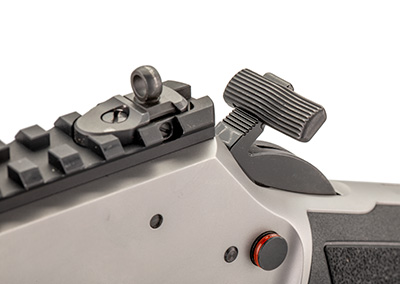
I was fortunate to have been paired with Grant Dubuc, S&W’s director of product innovation, who is not only a mechanical engineer but who has been with the company for 15 years and has been intimately involved with its revolver production. When asked how long Smith & Wesson had been working on the Model 1854, he explained, “We had a working prototype within three months, but the gun has been in development for two years.” He said engineers had examined other lever-actions on the market and used 3D printing extensively to prototype the first guns’ receivers and other parts. “Feeding and chambering and getting the lever and lifter arm right were the biggest challenges.” The team even sought the expertise of the company’s Performance Center to enhance the rifle’s sear.
Such attention to detail through the CNC-manufacture of components ensures that the gun’s internal parts mate properly by way of precise angles and radii—exactly the approach that today’s manufacturers must take to produce modern lever-actions that feel smooth, operate well and come in at a price point that provides acceptable profits. In the case of the Model 1854, Smith & Wesson seems to have taken the time to refine its components in such a way as to achieve flawless mechanical operation. The guns are manufactured at the company’s longtime headquarters in Springfield, Mass., with the receivers being forged on the same massive drop hammers that have been used for decades to pound out revolver frames. When I asked Dubuc if he felt the Model 1854 met the expectations that grew from the project’s launch, he was quick to cite his teammates’ efforts in what seemed to me to be a genuinely humble assessment: “We did a good job with it.”

My opportunity to verify that claim came on the first day of the hunt when a group of wild hogs seemed intent on hanging out far out of range of the two of us at a nearby pond. Having observed several acceptable examples from inside a ground blind, neither of us was able to get a shot within the hoped-for range of 50 yards. Finally, we elected to get out and station ourselves among a cluster of mature oaks and boulders nearby. Not long afterward, part of the herd, including two worthy animals, came toward us. I managed to hit one right behind the ear at 8 yards, which sent it circling around us, so I wheeled and sent another shot into its rear end as it fled. But the tough hog kept on running and was making its way back toward the pond when I hit it again from a standing position at 80 yards. After at least one more shot to ensure that it was down for good, I had finally dispatched the roughly 225-lb. sow. The Model 1854, Vortex scope and Hornady ammunition all performed as intended, with the rifle shouldering and cycling so quickly that it served as the proverbial extension of my arms and eyes during the melee. In all, I had gone through half the magazine’s ammunition in a matter of a few seconds.
In Hand
When first handling the Model 1854, several details stand out: The natural-finish metalwork and polymer stocks of the weather-resistant version are the obvious tipoffs that this is not your grandfather’s lever gun. Further, the M-Lok slots in the fore-end, while tastefully integrated, signal a fully modern rifle. And even though the latter are lacking on the walnut-stocked models, both have stippled panels on the pistol grip area and fore-end that greatly enhance purchase even when hands may be sweaty or the weather takes a turn for the worse. Other shared, decidedly modern, cues include the flat, serrated-face trigger and Torx-head action screws. The big-loop lever forms a generous enough oval to easily accommodate even larger, gloved hands and lends itself to manipulating the action positively and rapidly without crowding the fingers. A projection at its top disengages a trigger-block safety when the lever is fully closed against the stock.
The 19.25" barrel has broach-cut rifling in an eight-groove pattern and at a 1:20" twist rate. It measures 0.90" in diameter at the breech and 0.825" at the muzzle end, which is threaded 11/16x24 TPI to accept a brake or suppressor. The latter would be an excellent way to go as, frankly, the recoil of the .44 Mag. cartridge in a carbine simply isn’t significant, and the Model 1854’s relatively short 36" overall length would still be reasonably handy with a short can attached. The barrel’s rather stout profile may account for the gun’s admirable accuracy, and its length allows the magazine tube to accommodate nine rounds for an all-up capacity of 10 rounds of .44 Magnum or .44 Spl.—offering no small hedge in big-bore power in the hunting fields or in defensive encounters. It’s worth noting that the Model 1854’s owner’s manual discourages the use of +P loads and entirely disallows +P+ ammunition.

The round-cross-section bolt measures 0.667" in diameter and features a pinned, spring-steel extractor, and a leaf-spring-powered ejector fits a mortise in the receiver’s left wall. The gun’s method of operation is not unlike that of similar models from other makers before it, with the tip of the operating lever engaging a slot in the bolt to run it fore and aft. A cutout on the bolt’s underside mates with a locking block to secure it in battery, and firing cannot occur unless the lever is closed fully to deactivate the trigger-block safety. Dubuc said the bolt’s size was designed for compatibility with other chamberings planned to expand the line in the future. While .45 Colt has already been announced, he forecast that .357 Mag. would follow and further hinted that a .22 Long Rifle version was not out of the question. He also added that, with a re-design of the receiver and attendant parts, the .45-70 Gov’t and .30-30 Win. were on the short list. When asked about the possibility of a .500 or .460 S&W Mag. lever gun, he would not commit but did say it was under consideration.
Perhaps the S&W’s most unique feature is its detachable magazine tube. Rather than permanently affix an outer tube to the receiver and barrel—allowing for loading through the side by withdrawing an inner tube as do many rimfire and some centerfire designs—engineers elected to make the single 0.625"-diameter tube entirely removable from the gun. Simply press down on the knurled cap and twist it one-quarter turn counterclockwise from the muzzle end and the tube can be withdrawn from its hanger, which is dovetailed to the barrel. The advantage is that the user can safely and quickly unload the gun without working live cartridges through the action. While unconventional, the design appears to be a wise choice regarding safety, although it requires that the user be aware that, when the tube is removed, up to the full load of nine cartridges can simply cascade out of the gun. When the magazine is in place, a bright orange follower at the breech end of the tube, visible when the loading gate is depressed, indicates that the magazine is empty.
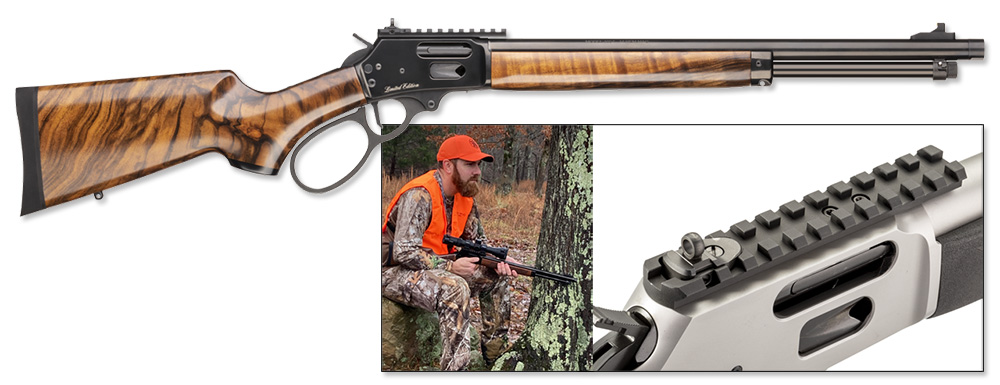
In Testing
Throughout 250 rounds of firing a variety of loads ranging from 180-grain soft points to 240-grain jacketed hollow points—including running through the American Rifleman protocol of five, five-shot groups with three different loads to produce the accompanying accuracy results—the Model 1854 exhibited perfect functioning and remarkable accuracy. I had already noted its ability to print small groups during an informal session at the lodge’s range during the hunt—several times managing to place three shots into 2.5" firing prone from a few paces shy of 100 yards using the Vortex scope set at 10X. Later, at NRA Headquarters, American Rifleman Managing Editor Christopher Olsen conducted a formal accuracy evaluation at 50 yards using a Leupold VX 5HD 3-15X 44 mm optic at its highest setting, producing an average extreme spread of 1.51". Those results belie the demands of such a stringent regimen on a lever-action rifle built with a two-piece stock and fired off sandbags, yet, according to Olsen, the Model 1854’s obvious penchant for accuracy was largely unaffected by the various ways he rested it on the supports. One load that did defy tight groups was Remington’s UMC 180-grain jacketed soft point, which produced 4.5" five-shot groups. One .44 Spl. load, the SIG Sauer V-Crown 200-grain JHP, was also tested and resulted in respectable groups averaging just under 2".
Olsen also noted that despite the Model 1854’s stout barrel contour—and he neither rushed nor tarried to produce the groups on target—heat built up rapidly in the gun as he worked a magazine full of ammunition through it, especially the 240-grain loads. The gun’s shootability was enhanced by its flat-faced trigger, which features a small lobe near the tip that aids consistent finger positioning. It broke consistently at 4 lbs., 6 ozs., and exhibited a crisp letoff with a small amount of takeup and no creep. Of course, depending on the chosen load, and the user’s preferences and vision, the Model 1854’s factory iron sights should lend themselves to practical field accuracy since the sight picture is intuitive, the radius is a generous 21.25", and there is enough elevation and windage adjustment to account for a range of bullet weights.
Removing the rifle’s operating lever pivot screw with a T20 Torx wrench is all that’s required to detach the lever and the bolt from the receiver, thus fieldstripping the mechanism for routine cleaning and lubrication. An included hammer spur extension can be attached to project either to the right or left side of a mounted optic to aid placing the gun in its half- or full-cock positions, and the crossbolt safety is pressed from right to left to fire.
In The End
Smith & Wesson’s current advertising campaign for the Model 1854 keys on the word “smooth,” and after spending some time with it, I can understand why. Not only does the gun have appealing lines, its internal engineering results in fluid operation. Such has long been the hallmark of beloved lever-actions. In fact, the only thing stiff about the Model 1854 is likely to remain in the form of competition—something from which S&W has never retreated. That Smith & Wesson has chosen to take on the lever-action market at all is evidence that it possesses a healthy sense of corporate intuition and no small measure of marketplace boldness. Owing to its famous brand affiliation, high-quality of manufacture and smart design, the Model 1854 will no doubt strike a chord with lever-action aficionados. It would be an ideal companion to a .44 Mag. revolver—especially one bearing the S&W logo.
Horace and Dan B. would likely be amazed at the new Model 1854’s refinement—its smoothness and firepower—and at how the company is in full-swing and has come full-circle since the days they founded it. They would no doubt be proud, too.













